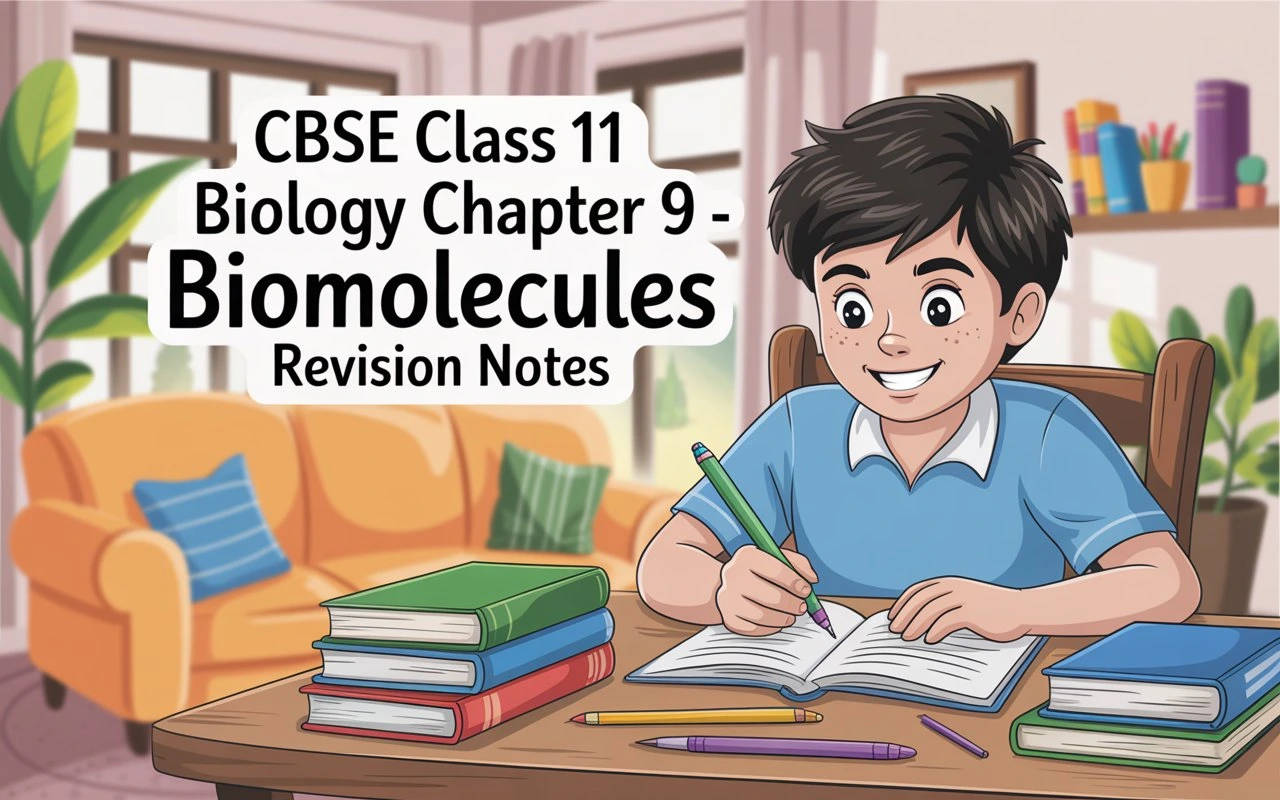CBSE Class 11 Biology Chapter 9 - Biomolecules Revision Notes and Solutions 2025-26 (NCERT)




The study of life begins at the molecular level. Every cell, tissue, and organ in our body is made up of chemical compounds known as biomolecules. Chapter 9 of Class 11 Biology – Biomolecules – helps students understand how these compounds form, interact, and drive the processes that keep us alive.
This blog explains the major concepts of Biology Chapter 9 biomolecules in a simple way, following the Class 11 NCERT syllabus. Whether you’re revising before exams or brushing up on basics, this quick guide will make the topic easier to understand.

Biomolecules are organic and inorganic chemical compounds that form the basis of life. They include substances such as carbohydrates, proteins, lipids, and nucleic acids. Each plays a special role in maintaining the structure and function of living organisms.
These molecules are found inside every cell and participate in essential biological processes – from providing energy to carrying genetic information. The Biomolecules Class 11 NCERT chapter is therefore one of the most important lessons in zoology, linking chemistry with biology.
Carbohydrates are the body’s main source of energy. They are composed of carbon, hydrogen, and oxygen, usually in the ratio 1:2:1.
Types of carbohydrates:
Functions: They provide instant energy for cellular activities, form structural materials (like cellulose in plants), and help store energy in the form of glycogen in animals.
Proteins are large, complex molecules made of smaller units called amino acids. They are essential for the structure, function, and regulation of body tissues and organs.
Structure of proteins:
Functions: Proteins act as enzymes, hormones, antibodies, and transport molecules. They also repair tissues and help in muscle formation.
Lipids are compounds made mostly of carbon, hydrogen, and oxygen, but with a much lower oxygen proportion than carbohydrates. They include fats, oils, waxes, and phospholipids.
Functions:
Lipids are insoluble in water but dissolve in organic solvents like alcohol and ether.
Nucleic acids are the molecules that store and transmit genetic information. They are of two types – DNA (Deoxyribonucleic acid) and RNA (Ribonucleic acid).
DNA carries hereditary information and controls protein synthesis, while RNA helps translate this information into functional proteins. Both are made of repeating units called nucleotides, each containing a sugar, a phosphate group, and a nitrogen base.
Among all biomolecules, enzymes play a particularly vital role. They are biological catalysts that speed up chemical reactions occurring inside living cells without being consumed in the process.
An enzyme is a protein that enhances the rate of biochemical reactions in the body. Most enzymes are proteins, but a few – called ribozymes – are made of RNA.
Every enzyme works in a specific way. It acts on a substrate – the molecule it reacts with – to produce an end product.
Overall reaction: E + S → ES → EP → E + P
This process ensures reactions that would normally take hours happen in seconds.
Every chemical reaction requires a certain amount of energy to get started – this is called activation energy. Enzymes lower this energy barrier, making reactions occur faster and more efficiently.
When comparing catalyzed and uncatalyzed reactions on a graph, the enzyme-catalyzed one always shows a smaller energy curve, meaning it reaches completion sooner.
Several conditions affect how well an enzyme works:
Sometimes other substances interfere with enzyme activity. These are called inhibitors.
To explore enzyme concepts visually, you can watch this detailed Malayalam explanation of the Biomolecules – Enzymes topic here:
Students preparing for CBSE Board exams should focus on the following question types from the Biomolecules Class 11 NCERT Solutions:
Solving these helps strengthen understanding and prepares students for both board and competitive exams.
Biomolecules form the foundation of all biological systems. Understanding their structure and function – especially enzymes – helps students grasp the molecular logic of life. With regular revision and the right guidance, this chapter can easily become one of your strongest scoring areas.
If you’re short on time or want to revise Class 11 Zoology chapters like Biomolecules effectively, Interval Learning’s Crash Course is designed just for you.
A crash course is a short-term, intensive program that helps students master important topics quickly. Instead of going through every detail, it focuses on what really matters for exams.
Prepare smarter with Interval Learning’s Class 11 Crash Course and build a strong foundation for the board.
Join Interval Learning’s Class 11 Crash Course today and make your preparation faster, smarter, and more effective. Contact us today!
Biomolecules are naturally occurring organic compounds such as carbohydrates, proteins, lipids, and nucleic acids that form the chemical basis of life.
Enzymes speed up biochemical reactions in living cells, helping the body perform vital functions like digestion, respiration, and energy production.
Activation energy is the minimum energy required to start a chemical reaction. Enzymes lower this energy so reactions occur faster.
Interval Learning offers personalized crash courses, one-on-one tutoring, and focused revision programs that simplify difficult topics and improve performance.
Yes. The Class 11 Crash Course includes NEET-oriented revision and question practice, helping students strengthen their base for medical entrance exams.